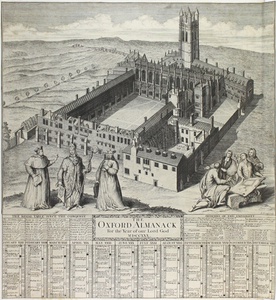| Method | Copper engraving |
| Artist | George Vertue |
| Published | [Oxford, 1730] |
| Dimensions | Image 344 x 444 mm, Sheet 580 x 440 mm |
| Notes |
The Oxford Almanack for 1730, depicting an aerial view of Magdalen College from the North, with Magdalen Bridge and fields in the distance. In the foreground, the founder William Waynflete, Bishop of Winchester, is flanked by Cardinals Wolsey and Pole. To the right, Lord Digby and the Bishop of Worcester stand with a pair of architects, examining the plans for a new quadrangle which had been commissioned the year before in 1729. The calendar for the academic year appears below the image, with a pair of boxed lists, of the royal line since the conquest of William I on the left, and of the officers of the University for 1730 on the right. George Vertue (1684-1756) was an antiquary and engraver. He was born in the parish of St. Martin-in-the-Fields, London. Vertue was apprenticed to a silver engraver and later to the Flemish engraver Michael Vandergucht. His early work includes plates after Kneller, whose academy he attended from 1711. Vertue had a deep interest in antiquarian research, and much of his work was devoted to this subject. He also served as the official engraver to the Society of Antiquaries (1717-56). From 1713 onwards, Vertue dedicated his research to the details of the history of British art, which resulted in an extensive collection of notebooks now in the British Library. The contents of which were the basis of Horace Walpole's 1762 'Anecdotes of Painting'. There are approximately five hundred portraits attributed to Vertue, and an equivalent number of published plates which were devoted to antiquarian subjects. Condition: Strong and clean impression. Trimmed to borders of image and laid to album page. Vertical fold to right side of sheet. Printed biography of Waynfleet from Skelton's Oxonia Antiqua Restaurata laid to page below almanack. |
| Framing | unmounted |
| Price | £400.00 |
| Stock ID | 42655 |

